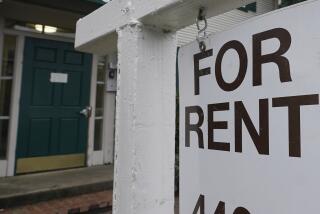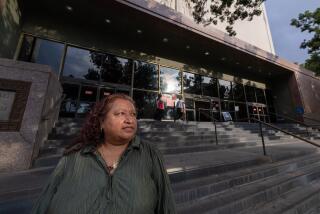Dear landlord,
Janine deBOISBLANC was bitter, and no one would have blamed her. She’d been apartment hunting for far too long -- five months, to be exact -- living out of her VW Jetta, couch-surfing, house-sitting, scrutinizing apartment listings. Even a two-week hospital visit was a welcome reprieve. “I thought, ‘Well, it’s a place to stay,’ ” she says.
It was nearly summer, the time of year when every college grad and landlocked dreamer has eyes for sparkly Southern California, and competition was already fierce. These days, the locals are looking too. Homeowners who sold for a bundle and banked the cash are renting while they wait out the inflated market. Then there are the hordes who must rent because they can’t buy -- only 23% of Angelenos can afford a median-priced home. Thousands of new units are built each year, but the vacancy rate continues to hover around 4%. Here, landlords can be choosy, and renters must compromise, cajole and pay up.
All of which had turned DeBoisblanc, an otherwise bubbly actress in her late 20s, into an exhausted nomad with hair-trigger senses, always on alert for that red-and-white “For Rent” sign poking out of the bushes, savvy enough to know that “charming” means “claustrophobic,” “artsy” means “abandoned by landlord” and “easy freeway access” might as well say “surrounded by a deafening roar.”
“I’ve looked at converted garages that they’re calling ‘guesthouses’ with water heaters in the middle of them for $995 a month,” DeBoisblanc says. “And I love it when they say ‘water included.’ ... I’ve seen places open for viewing that look like they were possible murder scenes.”
In the beginning, DeBoisblanc dreamed of living alone in Los Angeles in a one-bedroom for less than $1,000 a month on a street where she could safely walk her dog after dark. A Bay Area native who has lived in Manhattan, DeBoisblanc correctly assumed Los Angeles was the most affordable of the three. But that didn’t make her quest any easier.
Dozens of open houses later, DeBoisblanc got realistic and got a roommate, a college friend named Tim McCann. She made plans for the dog to live elsewhere. But McCann attends UCLA and wanted to live on the Westside -- where rents are 50% higher than the county average and finding a habitable two-bedroom, two-bath for around $1,500 a month is a soul-crushing exercise.
“Even if you start your day with all your resources and you’re very well organized, it’s just a matter of hitting that guy as he’s pressing the ‘For Rent’ sign into the grass,” she says.
The right intangibles
The first-come, first-served approach has its limits. Prospective tenants also need good credit (school loans can hurt you), a hefty security deposit (first and last month’s rent are usually required) and the right chemistry with the landlord. Just because you look good on paper doesn’t necessarily mean you’ll get the place.
Just ask Mark Verge, the owner of L.A.’s listings giant Westside Rentals, which features as many as 14,000 properties from Santa Monica to the Inland Empire to Orange County. This time of year an affordable apartment in the right neighborhood is usually rented the first day it’s shown. He recalls one place -- a two-bedroom for $1,100, three blocks from the beach -- that drew 20 people. Apartment seekers must make a good first impression.
“You’ve got to compliment the place, even if it’s a dump,” he tells his clients. “If you want it, you’ve got to make the owner think he’s created the greatest place in the world. I’ve seen so many people blow it by saying, ‘Are you going to change that wallpaper?’ ”
In some L.A. quarters, landlords have begun indulging their whims, sometimes bending antidiscrimination laws. They rent only to entertainment industry types. Or anyone but. They prefer “artists.” Or animal lovers. They want couples over 30. Or single women only.
In fact, in 2002, Verge’s company was among five L.A. rental services sued for discrimination by the Housing Rights Center, a local nonprofit organization, because they ran ads specifying “no children,” “near synagogue,” “Section 8 not accepted,” “adult building,” “will accept married couple 40 years and older” and “professional preferred.” As part of a settlement, the companies donated advertising to the Housing Rights Center and allowed it to screen ads for a number of months, as well as to educate rental staff on antidiscrimination laws. The companies also modified their websites to minimize a landlord’s ability to discriminate.
“Housing discrimination has gotten worse,” says Housing Rights Center executive director Frances Espinoza. “If you have a family, a lot of times ... choices are limited. Even now a lot of landlords don’t want children in their units.”
Perhaps the most famous of L.A.’s choosy landlords is Dave Goldstein. He requires each of his prospective tenants to write an essay describing why he or she deserves to live in one of the 70 Art Deco buildings he owns in the “yuppie areas” -- the Miracle Mile, Hancock Park, West Hollywood, Sunset Plaza, Larchmont, Los Feliz and Beachwood Canyon. If he likes your essay, you survive the first round of cuts.
If Goldstein likes your essay and you’re a Gemini or a Cancer and you drive a Saab and you’re in the entertainment industry and you are a minority of any kind (overweight, elderly and unattractive folks are welcome) and he likes the looks of your furniture (no futons) -- he’s got a high-ceilinged, hardwood-floored, crown-molded, Jazz Age hideaway for you.
Although unconventional, and legally risky, his approach works, Goldstein says. In 13 years, he’s evicted only three tenants. And he claims a loyal clientele.
“Last week, I had a couple girls who after they signed their lease and put down their deposit broke down and cried. Like, hard tears,” says Goldstein. “They cried because they said nobody was nice to them. They were crying because I was sincere about caring.”
He says he gave one a rent-free garage and let the other bring her dog.
Housing shortage
THE high cost of housing in Los Angeles is simply a matter of supply and demand, says Raphael Bostic, director of the Casden Real Estate Economics Forecast of the USC Lusk Center. Large numbers of people keep moving here, but organized neighborhood opposition to growth drives up the price of land and delays construction of new housing.
“It’s very much a sellers’ market, which means that rent prices aren’t likely to ease, and so my expectation is that it’ll remain a difficult market for potential renters,” Bostic says. “The region has to make a decision how development is going to take place. As long as it’s difficult to build, it’s going to be very difficult to address the affordability problem.”
Newlyweds Natalia and John Koudsi thought it would be no problem finding a two-bedroom, two-bath in the “low $2,000s.” They sold their beachside condo for $15,000 over the asking price (they won’t reveal the sale price) the first day it hit the market and needed a Westside apartment while building a new house in Pacific Palisades.
“We thought it was going to be easy,” says Natalia, a 31-year-old software developer. “Now we’re scrambling to find a place.”
In the first three weeks of their search, they hadn’t found much. There was the “total piece of crap” above the Broadway Deli on the Third Street Promenade -- a one-bedroom with a loft and view of Santa Monica’s rooftops for $2,700. Then there was the $2,300 two-bedroom, two-bath in West L.A. The only sunlight in the place was reflected off the building next door.
Nancy Oropeza, a customer service rep for Citigroup, meanwhile, needs two roommates to make that kind of rent. At 21, she’s leaving her family’s Moreno Valley home for the first time. She has spent three months looking for a three-bedroom, two-bath for less than $2,200 in a South Bay neighborhood where it’s safe enough to walk her Dalmatian. Oropeza favors places near elementary schools, she says, because anyone convicted of selling drugs within a mile radius gets extra time added to his or her sentence, according to state law.
“It’s hard,” she says. “A lot of the listings are already taken by the time you call them. Or they’re in bad areas.”
Eric Stoner, a Kentucky native who moved to L.A. a year ago after college graduation, considered himself lucky. He landed a $675-a-month studio in North Hollywood complete with a refrigerator. Yes, it was adjacent to a freeway. And an airport. And his parking lot exit was “left turn only” -- so he had to circle the block to turn right.
“But for the price range,” he says, “it was worth it.”
A few weeks ago, DeBoisblanc and her roommate signed a lease on an $1,800-a-month, two-bedroom, two-bath apartment, built in 1969, in the Brentwood area. It wasn’t her ideal, and the rent was more than she wanted to spend. But the apartment is well maintained and has a patio, and the neighbors are nice. More important, the search is finally over.
“We’re living without a fridge, Internet, cable or phone,” DeBoisblanc says in an e-mail sent from a Kinko’s. “But life is good.”
More to Read
Inside the business of entertainment
The Wide Shot brings you news, analysis and insights on everything from streaming wars to production — and what it all means for the future.
You may occasionally receive promotional content from the Los Angeles Times.










